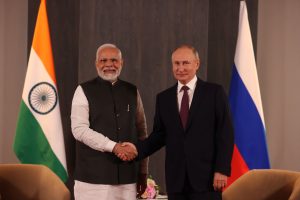Biswajit Dhar

Russia’s invasion of Ukraine has revived Cold War sentiments and triggered a major realignment of the global economy, with India at the center of it all.
In the first days of the conflict, the United States-led Western alliance imposed a slew of sanctions on Russia, including a ban on key Russian banks from the world’s dominant financial messaging system, SWIFT.
The ban prevented these banks, representing over 80 percent of total Russian banking sector assets, from conducting transactions quickly and efficiently.
The sanctions dealt a body blow to Russia’s ability to trade with partners, including India, one of Russia’s closest allies going back to the Cold War era.
Prior to its invasion of Ukraine, Russia was a relatively small trader with India, not figuring among India’s top 20 partners. In the 2021-22 financial year (1 April to 31 March), trade between India and Russia accounted for a meager 1.3 percent ($13 billion) of India’s total trade.
Where their relationship has been close has been in the supply of armaments, which has spanned decades. Since 2000, India has been the largest importer of Russian armaments, which was valued at $39.5 billion, according to the Stockholm International Peace Research Institute.
Russia’s supply of armaments to India is critical for a country in one of the most militarized and politically volatile regions of the world. In comparison, India’s imports from the U.S. were almost $5 billion.
Since the outbreak of conflict in Ukraine, the West had expected India — its strongest ally in South Asia — to support efforts to economically isolate Russia, an expectation that never seemed realistic given the strategic support that India was receiving from the Russians.
Immediately after the Russia-Ukraine conflict began, the India-Russia entente went several notches higher as commercial relations between the two countries expanded significantly.
In the 2022-23 financial year, India’s imports of crude oil from Russia increased nearly 13-fold, from less than $2.5 billion in 2021-22 to over $31 billion in 2022-23. Russia became India’s second largest source of crude oil imports with a share of 19.1 percent.
Imports of other major commodities of India’s interest, namely fertilizers and coal, also increased four-fold and three-fold, respectively. Consequently, Russia emerged as India’s fourth largest import source in 2022-23 with imports totaling $46.2 billion, 6.2 percent of overall imports.
The new financial year dawned with even better news for Moscow. In April 2023, Russia was India’s largest source of crude oil imports with a share of almost 33 percent and was the second largest import source overall with a 10 percent share. Russia’s share in India’s imports catapulted from 2.1 percent (in March 2022) to double digits.
India’s oil imports from Russia clearly provided a win-win situation for both countries. Reeling under sanctions, Russia – the third largest producer of crude oil – lost a large share of its export market, especially in Europe, which accounted for nearly a half of its exports at the beginning of 2022. This was when India stepped up its imports of crude oil from Russia, taking advantage of the hefty discount on offer.
In the 2022-23 financial year, India imported Russia’s Ural oil at an average discount of nearly 9 percent a barrel, compared to the price offered by its second largest source, Iraq. This discount had increased to 14 percent in April 2023, fuelling a surge in India’s imports crude oil imports from Russia.
The discounted oil imports could not have come at a better time for India as it helped the government address its own macroeconomic problems, arising primarily from surging prices of petroleum products.
Cheap imports of crude oil from Russia was a windfall for India’s export business as well.
Exports of petroleum products, the largest component of India’s export basket, increased by almost $30 billion (by 44 percent) during the financial year 2022-23, contributing significantly to the record levels of exports of $451 billion during the year.
Given this context, the most important development was the steep increase in India’s exports of petroleum products to the Netherlands by almost 2.5 times. Thirteen percent of India’s exports of petroleum products landed in the Netherlands’ Port of Rotterdam during 2022-23, which had increased to over 15 percent in April 2023.
Rotterdam, the most convenient location for supply and transit of crude oil in Europe, was fed by imports from India, helping EU members to partially obviate the supply shortages arising from the sanctions imposed on Russia.
The Western alliance’s economic sanctions aimed at isolating Russia has undoubtedly put India in a difficult position.
Delhi has had to weigh its geopolitical economic interests as a close ally of the U.S. in the Indo-Pacific region with its continued dependence on cheap Russian oil, coal, and fertilizers and armaments for meeting its domestic economic and strategic compulsions.
Given these choices, it is hardly surprising that India has opted for the latter.
This article has been republished as part of a Special Report into the second anniversary of the Ukraine war. It originally appeared on June 19, 2023.
No comments:
Post a Comment